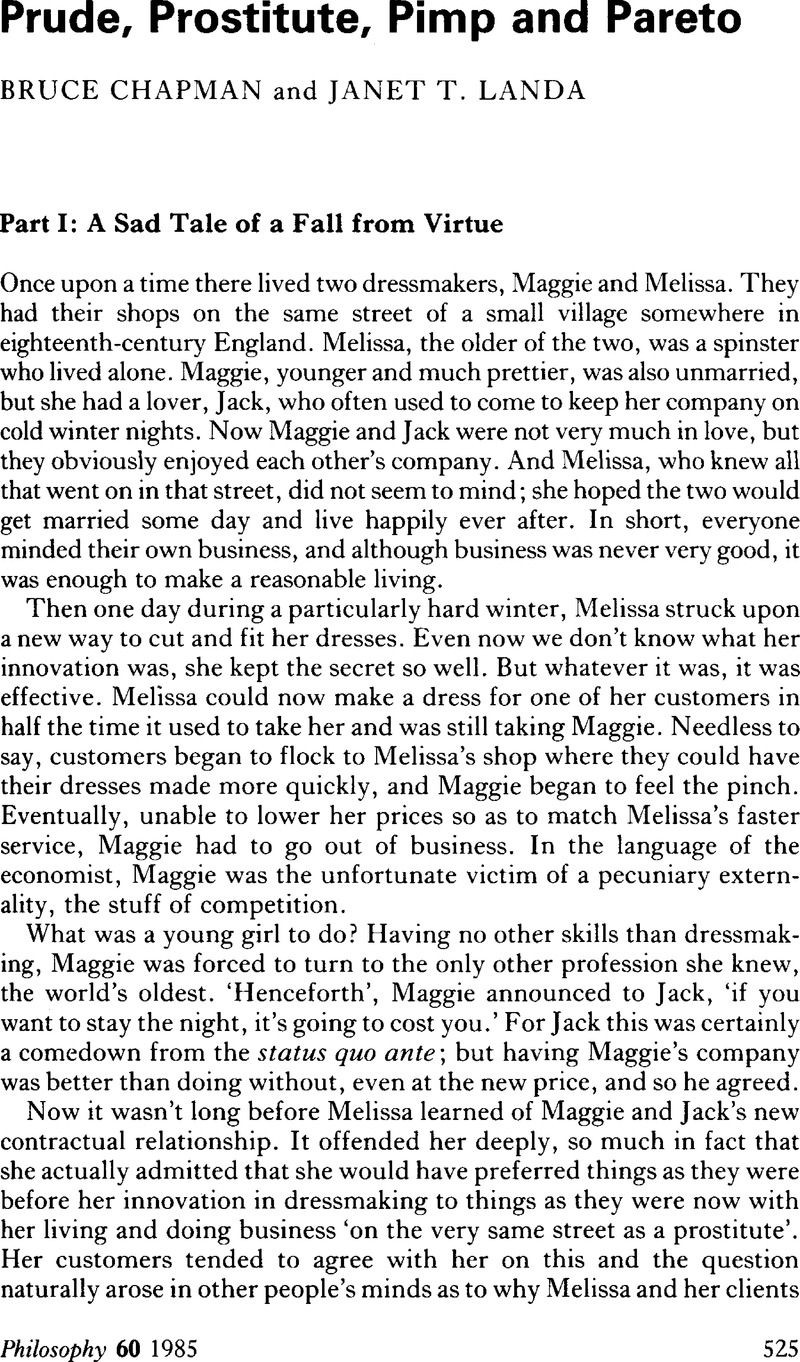No CrossRef data available.
Article contents
Prude, Prostitute, Pimp and Pareto
Published online by Cambridge University Press: 30 January 2009
Abstract

- Type
- Discussion
- Information
- Copyright
- Copyright © The Royal Institute of Philosophy 1985
References
1 Of course, Vilfredo Pareto was a nineteenthhypencentury figure, so the Duke's language is slightly anachronistic. However, we have tried to render this story intelligible and interesting for modern readers. No doubt the Duke had some term other than ‘Paretohypeninferior’ to refer to an outcome which everyone in society thinks is inferior to another which is available. The modern reader will doubtless recognize that our story of rightful contracts leading to a Pareto-inferior result has much in common with a problem highlighted by Amartya Sen in his article ‘The Impossibility of a Paretian Liberal’, Journal of Political Economy 78 (1970), 152–157.CrossRefGoogle Scholar
2 Condorcet published his Essai sur I'Application de I'Analyse aacute la Probabiliteacute des Decisions Rendues aacute la Pluraliteacute des voix in Paris in 1785.
3 The page's conjectures have since been proved.See, for example, Sen, Amartya, Collective Choice and Social Welfare (Edinburgh: Oliver and Boyd, 1970), Chs 10 and 10lowast.Google Scholar
4 Again, a less imaginative modern scholar has borrowed heavily from the page's arguments. See Chapman, Bruce, ‘Law, Morality and the Logic of Choice: An Economist's View’, University of Toronto Lave Journal 29 (1979), 114–137.Google Scholar
5 It should be noted that this story takes place after 1789.
6 The Duke's ideas were soon to spread throughout the land. See, for example, the legal cases of Pearce v. Brooks lsqb1861rsqb All E.R. 102 at 104, and Upfill v. Wright lsqb1911rsqb 1 K.B. 506 at 512. In the latter case, Bucknill, J. argued: ‘... the law will not allow a contract which is tainted with immorality to be enforced’.Google Scholar
7 The Duke may have hit upon an explanation for why Patrick Devlin thinks the law has a duty to enforce only moral, and not immoral, contracts between consenting adults. For an exposition of Devlin, 's views, see his book The Enforcement of Morals (Oxford: Oxford University Press, 1965).Google Scholar
8 We will probably never know whether or not Will was the original
9 In more recent times, economists have been known to argue that individuals devise a great number of institutions to lift themselves out of anarchy, where life for everyone is ‘nasty, brutish and short’, into civilization, where life is better for all. See, for example, Landa's work in the preceding footnote as well as her article ‘A Theory of the Ethnically Homogeneous Middleman Group: An Institutional Alternative to Contract Law’, Journal of Legal Studies 10 (1981), 349–362. However, the arguments in this paper suggest that social institutions like money or the middleman can just as easily result in a move from a Pareto-optimal to a Paretohypeninferior state of affairs.Google Scholar
10 This paper, originally entitled ‘Prudes, Prostitutes, Pimps and the Pareto Principle: Some amplications of Public Choice Theory for the Legal Enforcement of Morality’, was presented at the European Public Choice Society Annual Meetings, Florence, Italy, 17–19 04 1980.Google Scholar




